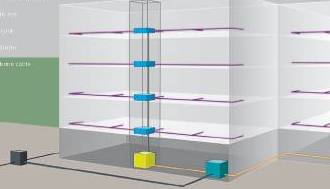The need for high reliability and continued cost efficiency, has established a widely accepted cabling concept in recent years; well defined today in international standards like EN50173-5 or TIA942.
Data centres are split into four levels that help allocate the typical services and applications. The Client level contains devices like a server – be it desk top, rack format or even the modern blades – and all kinds of storage devices and systems like SAN or NAS, including tape-recording devices for backup purposes. Access switches are situated at the next level, made to couple and connect all devices from client level. The Core level in data centres forms the gate-way with firewall functionality, to the group of network service providers connecting the data centre to the outside world.
This scenario is closer to some data centre operators than many might think. ISPs are already facing bottlenecks in their data centre backbones, and desperately seeking a superior solution. Within the next 3 years, migrations will take place that the infrastructure design will need to cope with. Enterprise data centre operators recognized electronic mail as the key application to improving efficiency in their organization. The reported annual growth rate of email data traffic is around 25%. Data centre hosts see all these trends raised to a higher power. Hence upgrading is a relevant option to all data centre operators, it’s just a matter of time.
What’s needed to meet future data centre requirements in Copper cabling?
In highly concentrated data centre networks, at server level (Client), the key is to maximize utilization of available pathways, racks and spaces, rather than to go for maximum permissible channel length. The required channels of 20m to 60m average distances give room for optimized designs in cabling.
For this application, Draka has developed the new UCFuture program which contains slim cable designs based on existing work area cable standards, which are perfect for zone cabling in data centres because of these characteristics:
- Up to 100% higher packing density in cable trays
- Fully compliant with established cable standards
- PIMF design to eliminate any Alien-Xtalk interferences
- Full 10GBase-T performance over a channel distance of 70m
At Client level especially, bulky cabling forms a serious barrier to air ventilation, literally one of the hot topics in data centres due to growing packing density in server racks, and the need to offload the high amount of heat dissipated by all the electronics.
Slim designs at server level, like the blade technology, should be consequently transferred to slim cabling.
The advantages of this new cable design can be leveraged to most suitable slim-design connectivity products, which give new opportunities for extended customer-specific service concepts.
Minimum required transmission performance of cable and cabling is Cat6A and/or Class EA. The rationale is to ensure easy migration of services to 10GBase-T, for which cable standards based on various technologies were made. Using 10 Gigabit Ethernet in data centres puts the attention to additional aspects:
- Products have shorter life cycles than in enterprise networks
- The entire Infrastructure (building, electricity, access protection etc.) is much better defined than in office buildings
- The packing density of installations is by far higher
Each of these factors promote the choice for future proof PIMF cable design, users of which enjoy high transmission performance headroom, along with its immunity against Alien-Xtalk. It’s the perfect fit to all the other devices and systems in a data centre.
Fibre Infrastructure requirements
Data centre backbones are already equipped with optical fibre technology. Optical fibre technology offers lowest attenuation, highest bandwidth, and longer link lengths. Thus supporting the highest data rates – a prerequisite for backbone data links. Within data centres it forms one of the most critical components due to the highly aggregated data traffic there.
As soon as 10 Gigabit Ethernet is on the agenda at client level, a data centre backbone, capable of 10GbE to link access and distribution levels, turns into a real bottleneck. Despite the fact that copper data cables can cover a distance of up to 100m at 10Gbit/s, the preference in this place should be laser optimized multi-mode fibre, according to the OM4 specification.
Today’s recommendation is clearly to take this a future proof solution, which is the only short-link technology that’s also part of the 40 Gigabit Ethernet, and likewise 100GbE Ethernet. It is based on multi-lane structures of OM4 or OM3 channel links. A data centre backbone in OM4 can therefore be easily expanded to the Next Generation Ethernet and secures investments for a longer pack-off time.


